Nestled within the heart of central Texas lies a tranquil yet adventurous body of water known as Canyon Lake. As one of the most sought-after fishing spots in the region, anglers from all over flock here year after year, hoping to catch trophy-sized bass, sunfish, catfish, and many other varieties of gamefish.
The size of this reservoir alone makes for quite an impressive sight — boasting thousands of acres of expansive space. It offers ample room for any outdoor enthusiast to explore at leisure. Discover why Canyon Lake reigns supreme among Texan freshwater fishing spots through this article.
Size and Depth Measurements
Canyon Lake, hidden in the Texas Hill Country, is a reservoir created by the Canyon Dam on the Guadalupe River. This dam stores a staggering amount of water, approximately 382,000 acres or 0.471 cubic kilometers. The lake spans 8,230 acres, with its shoreline stretching 80 miles (130 kilometers).
Canyon Lake is comparatively small compared to nearby reservoirs like Lake Travis and LBJ. Lake Travis has an impressive surface area of 18,929 acres. It can hold up to 1,130,000 acres of freshwater! Its winding coastline stretches over 270 miles (430 kilometers). Lake Travis plunges as low as 210 feet below sea level.
Lake LBJ might not have such mind-boggling stats to flaunt, but it still makes a solid case for itself. It stretches over 6,534 acres (26.4 sq. km), holding back a healthy amount of fresh water measuring up to 125,000-acre⋅ft (0.154 cubic kilometers) within itself. Its shoreline spans 150 miles (240 km). Its maximum depth is around 90 feet (27 meters).
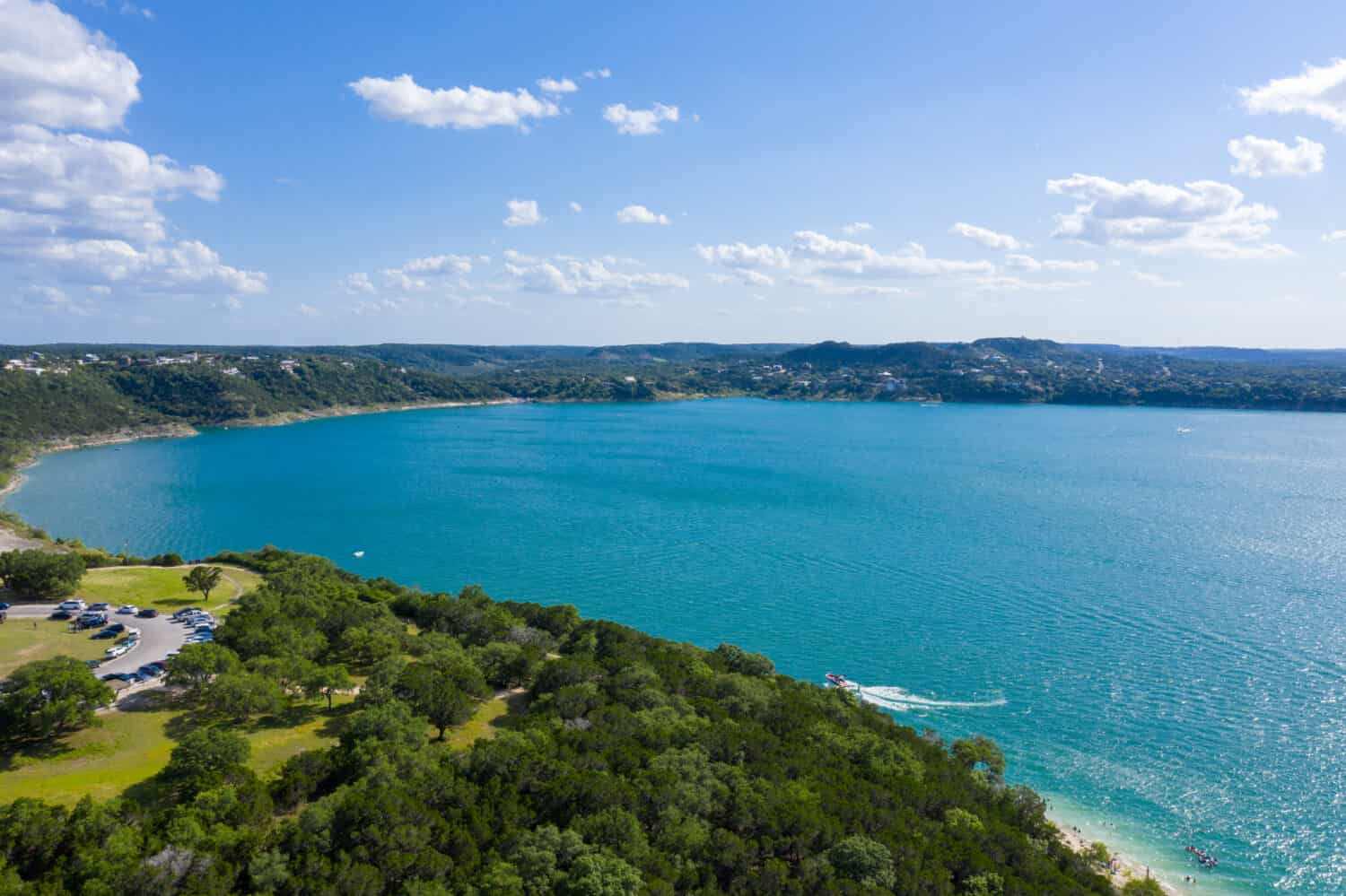
©Dana Rasmussen/Shutterstock.com
Water Quality and Temperature at Canyon Lake
Canyon Lake gets decent marks for its cleanliness and transparency. Its temperatures can swing quite a bit throughout the year, dropping to around freezing during chilly months before soaring up past 80 degrees Fahrenheit on hotter days.
Predominant Fishing Species at Canyon Lake Texas
Guadalupe Bass
The official state fish in Texas is the Guadalupe bass, a special kind only found in the Edwards Plateau area. These basses resemble smallmouth bass but have thinner bodies and a black strip down their sides. Anglers might find them swimming in moving waters by big rocks or logs in certain parts of Canyon Lake. You may need to use bait like bugs, shrimp, or tiny fish to catch one. If lucky enough, someone could snag a trophy weighing as much as six pounds! Generally, April through August are prime times to try reeling these rare beauties!
White and Striped Bass
White bass and striped bass are two types of fish that migrate along the Guadalupe River due to changes in seasons and water conditions. These migratory fish travel together as part of schools while consuming shad and other small fish as food. Anglers may spot them swimming in open waters or closer to dams.
These fish weigh around 10 pounds or more at maturity. They offer thrilling fishing experiences thanks to their size and fighting abilities. If you want to catch some white bass, your best chance is during the cold months of winter and spring when they head upstream to reproduce. Striped bass thrives during warmer weather from June through September, seeking refuge in deeper, cooler waters.
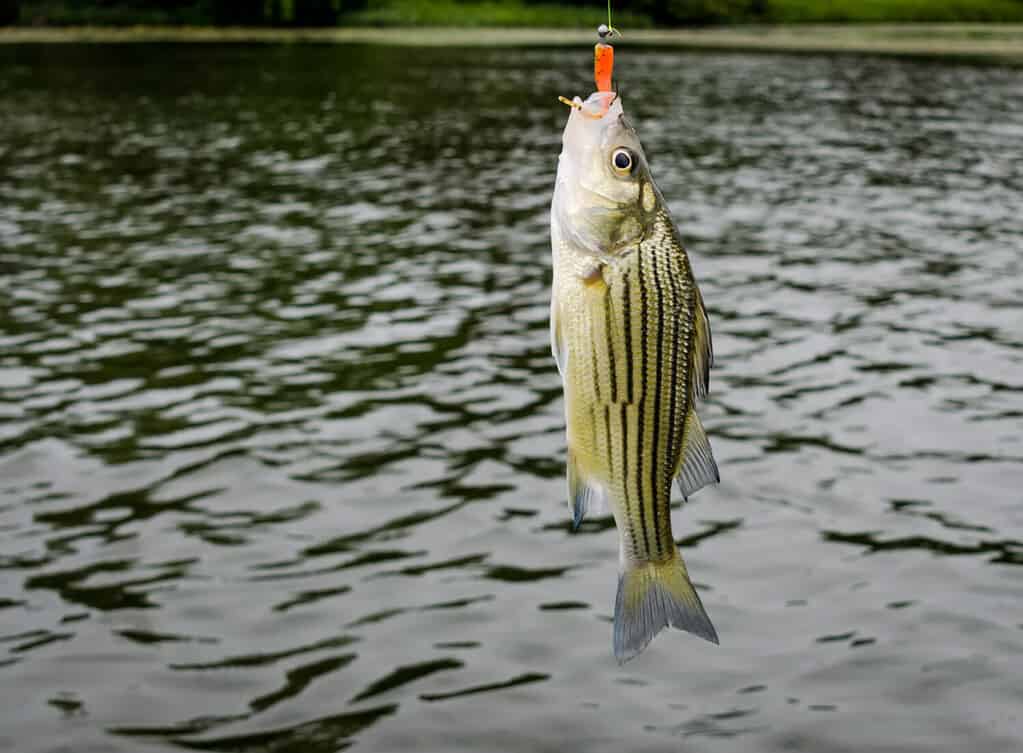
©HildeAnna/Shutterstock.com
Largemouth Bass
Many people love going after largemouth bass at Canyon Lake because they’re known to resist getting caught. Some lucky anglers, even land, some weighing over 10 pounds. The biggest one ever pulled out of these waters measured nearly 26 inches long. Brenda Salazar caught his monster back in July 2001.
Consider casting your line during the colder months of spring, autumn, and winter. During these seasons, the bass will be swimming around in search of food as they adapt to changes in their environment. Summer months may prove challenging as hotter waters and increased boat traffic could hinder your efforts. To increase your odds even further, focus on setting out your lines earlier in the mornings or late afternoons. That’s when these basses tend to come closer to shore and indulge in their meals.
There are several prime locations to fish for largemouth bass in Canyon Lake. Basses like to lurk near structures that offer them hiding places and hunting opportunities. Rock formations, underwater cliffs, submerged trees, and marina infrastructures attract more bass than open water areas. Popular hotspots among professional fishermen include:
- Canyon Park Cove
- Turkey Cove
- Jacob’s Creek Park Cove
- Crane Mill Park Cove
While these regions yield better results, consider other factors when selecting your fishing destination. These include weather conditions, time of day, seasonal patterns, and your skill level.
Catfish
In this vast reservoir, you’ll find a wide range of catfish species, including:
Blue Catfish
Blue catfish reign supreme in size and strength, with some specimens weighing in at a hefty 50 pounds or more! These behemoths lurk in deeper waters, dining mainly on shad, carp, and other fish. While these massive creatures make for a formidable opponent, the rewards for successfully landing one could earn you legendary status.
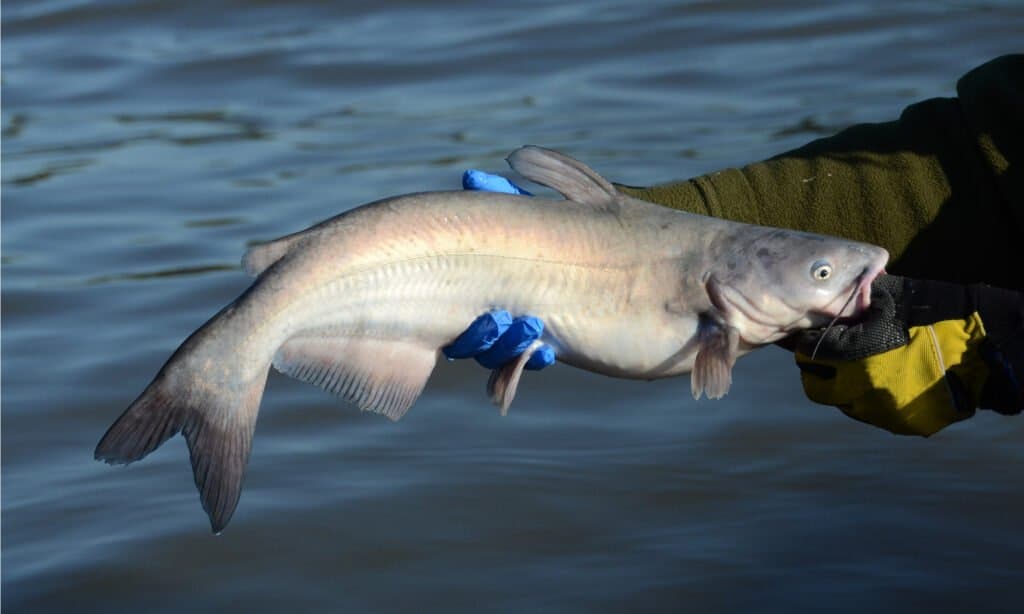
©M Huston/Shutterstock.com
Channel Catfish
Channel catfish may not hold quite the same punch as their larger cousins, but their prevalence in Canyon Lake makes them accessible targets for any angler. Usually tipping the scales between two to five pounds, they tend to stick closer to shore, where they feast primarily on worms, shrimp, and stink bait. Channel catfish is perfect for beginner or intermediate-level anglers seeking a satisfying catch without delving into murkier depths.
Flathead Catfish
Flathead catfish dwell mostly in deep pools and pose a challenge even for seasoned veteran fishermen. They weigh upwards of 20 or 30 pounds on average. As ambush predators, they conceal themselves amidst underwater structures while eating any unfortunate fish wandering within striking distance.
Catfish demonstrate consistent activity levels throughout the calendar year — albeit some periods prove more fruitful than others. In the summer, they prefer to come out at night and are less likely to bite during sunny days. Although weather conditions certainly impact their propensity to bite, two seasons are ideal for catfishing in Canyon Lake. Spring and autumn offer the perfect mix of environmental conditions, ensuring the greatest success for anglers eager to haul in these aquatic giants.
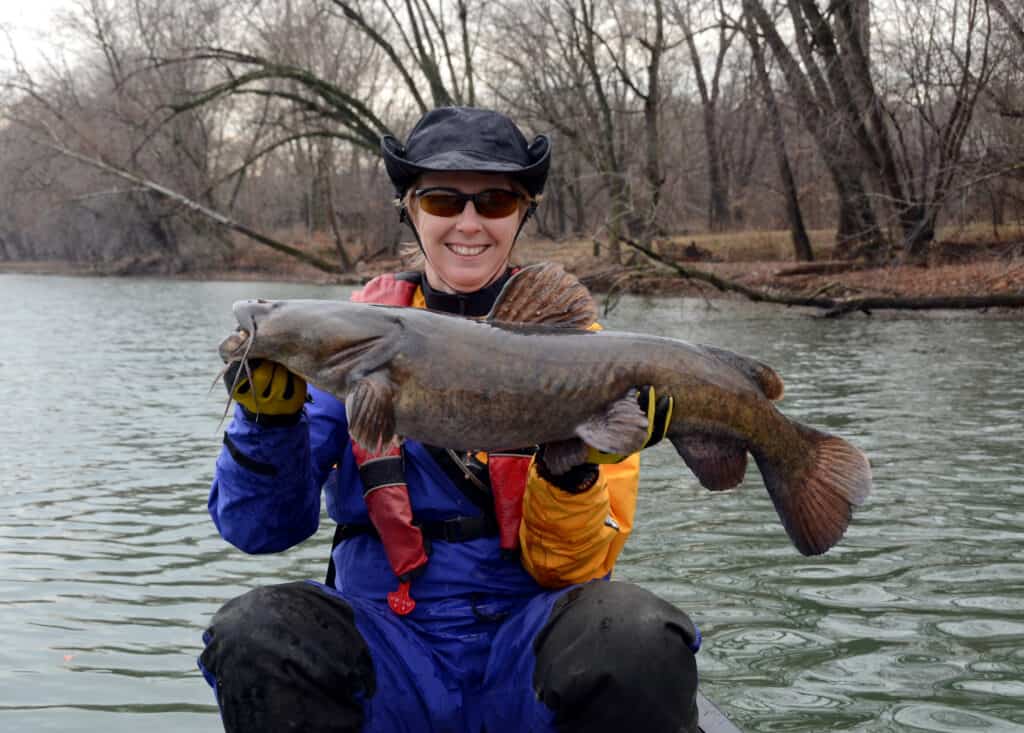
©M. Huston/Shutterstock.com
Smallmouth Bass
Smallmouth basses aren’t native to Texas but made it into Canyon Lake in the 1970s and 1980s. They put up quite a fight when you pull them out of the lake! They enjoy hanging out in specific areas like dams, islands by Comal Park, and especially at rocky shorelines.
Smallmouth basses come in all shapes and sizes in Canyon Lake. You never know which ones you may end up pulling out, but usually, they stay pretty average at 14 inches long and 2 pounds heavy. These predators thrive in transparent aquatic environments with moderate temperatures (between 74°F – 80°F) and plenty of cover (like rocks or rubble). Anglers who want to reel one in should focus on areas like the dam, a nearby island, or rocky coastlines.
Fishermen seeking a prime catch at Canyon Lake would benefit from visiting during the spring and autumn. During this period, the smallmouth basses are more active, partly due to the ideal water temperature range (roughly 13°C to 21°C. When you arrive, bring along a selection of effective bait options, such as:
- Crankbaits
- Spinnerbaits
- Jigging spoons
- Soft plastics (worms)
- Live minnow baits
Fly-angling enthusiasts may elect to employ streamers or poppers instead.
Sunfish
Sunfish species provide a fun challenge to anglers at Canyon Lake due to their small size and energetic nature. These diminutive freshwater fish exhibit gorgeous scale colors and ornate fins with sharp spines. Avid fishermen will encounter multiple types of sunfish throughout this body of water, ranging from bluegill to green sunfish. Although tiny, don’t underestimate their strength and determination once hooked.
Along the shoreline, anglers can discover sunfish camouflaged amongst rocks, vegetation, and artificial structures. Bridges, reservoir control structures, and marina complexes may be potential hideouts for these lively panfish. Despite consistent activity across all four seasons, sunfish numbers peak during the warmer months. Prime feeding windows occur just after dawn or before nightfall.
Don’t worry about investing in a high-end tackle or specialized baits when setting your sights on landing sunfish. A simple spinning setup with a lightweight line and a modest hook suffice for successful angling. Live bait selections like worms, crickets, or corn kernels work fine. However, you might also experiment with small soft plastics or metal lures. These little ones will readily bite natural and synthetic baits, given their omnivorous nature.
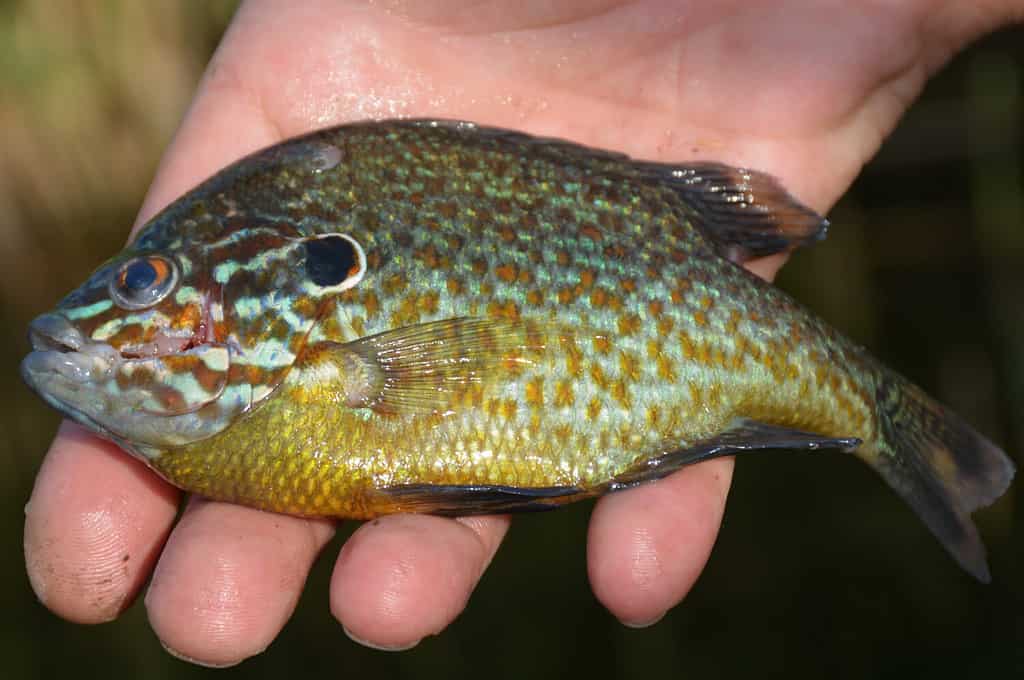
©Self-taught/Shutterstock.com
Crappie
In the realm of fish species that call Canyon Lake home lies the crappie, another branch of the sunfish family tree. They average 15 inches long and weigh no more than 4 pounds. Their external appearance features metallic silver bodies covered with round black spots and large mouths. While these fish species frequent diverse sections within the lake, avid anglers commonly spot them swimming amidst submerged trees in flowing rivers. They migrate toward colder waters during summer before relocating closer to the surface once cold weather arrives.
Canyon Lake is ideal for catching crappie during late fall to early spring when these fish actively feed on baitfish like shad and minnows. Both live and artificial lures like jigs, spinners, and spoons work well to attract these fish. Be cautious, though — crappies have notoriously light bites. So stay attentive and react swiftly to any subtle movements on your line.
Wildlife Around Canyon Lake
Travelers driving away from urban areas to explore the Guadalupe region should prepare themselves for a unique encounter with Mother Nature. Spotting local fauna like fish, foxes, ducks, foxes, and avian creatures scurrying around seems almost guaranteed.
Land Animals and Birds
Amidst the terrain far away from the water, numerous animals reside. In this locale, one might come across:
Pay close attention if you see soil flying through the air, as this could indicate the presence of a banded armadillo burrowing underground. In areas where the river flows alongside exposed limestone formations, keen observers might catch sight of elusive bobcats or shrewd long-tailed weasels.
Avian enthusiasts might appreciate sightings of the endangered Golden-cheeked warbler and Black-capped vireo. Keep your eyes peeled for the aerial antics of the Belted Kingfisher, American Goldfinch, and American Kestrel.
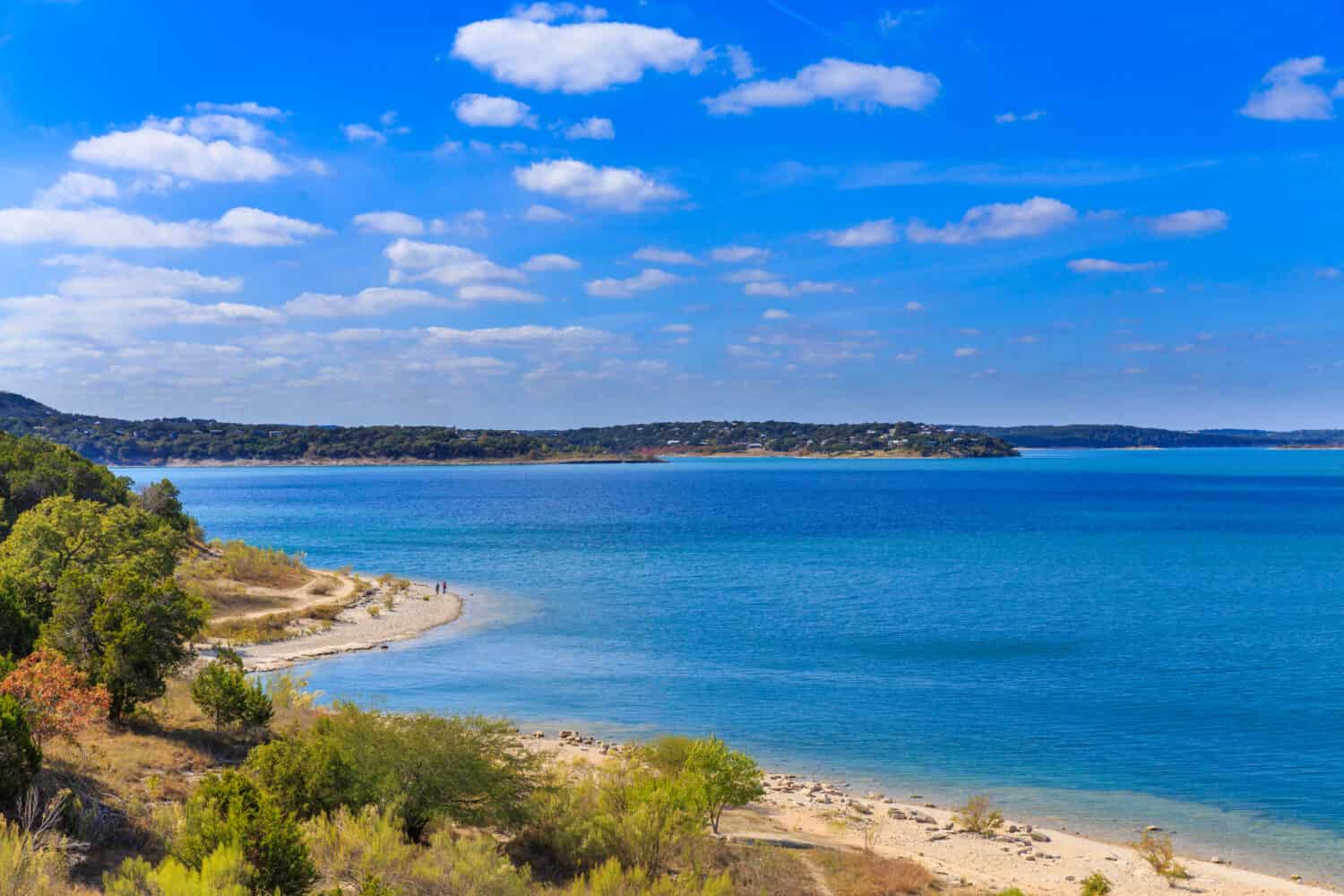
©Tricia Daniel/Shutterstock.com
Fun Things to Do at Canyon Lake
Canyon Lake has a charm waiting for every type of explorer seeking joy in leisure and adventures. Here are some fun things to do in Canyon Lake, Texas:
Enjoy Water Activities on the Lake
When visiting Canyon Lake, you’ll have access to 8,230 acres of crystal-clear water spread across 80 scenic miles of shore. Enjoy swimming, boating, fishing, and jet skiing amidst beautiful surroundings. Rent boats and gear from nearby marinas or book guided tours and private charters for a more immersive experience.
Explore the Parks Along the Shore
Nestled near Canyon Lake lies many recreational treasures in the form of parks flaunting access to pristine waters, plus an assortment of amenities, including:
- Picnic spots
- Playgrounds
- Restrooms
- Cozy campsites
Some prominent destinations within these verdant havens include:
- Overlook Park: Experience a majestic panorama of the lake and Canyon Dam while leisurely walking along its promenade or basking in the green picnic grounds.
- Potter’s Creek Park: Indulge in nature by pitching a tent at one of the more than 100 campsites (some equipped with utilities), casting lines off the shore, or simply zooming away from the boat ramp.
- Canyon Park: Unleash your adventurous side via a hiking trail and kayak/paddle board rentals from the park store. You can also chill out on the sandy beaches while watching fellow enthusiasts play beach volleyball games.
- Comal Park: Rejuvenate by soaking up the warm sunshine, enjoying sandy moments, or indulging in a family get-together beneath the sheltering gaze of the picnic pavilion.
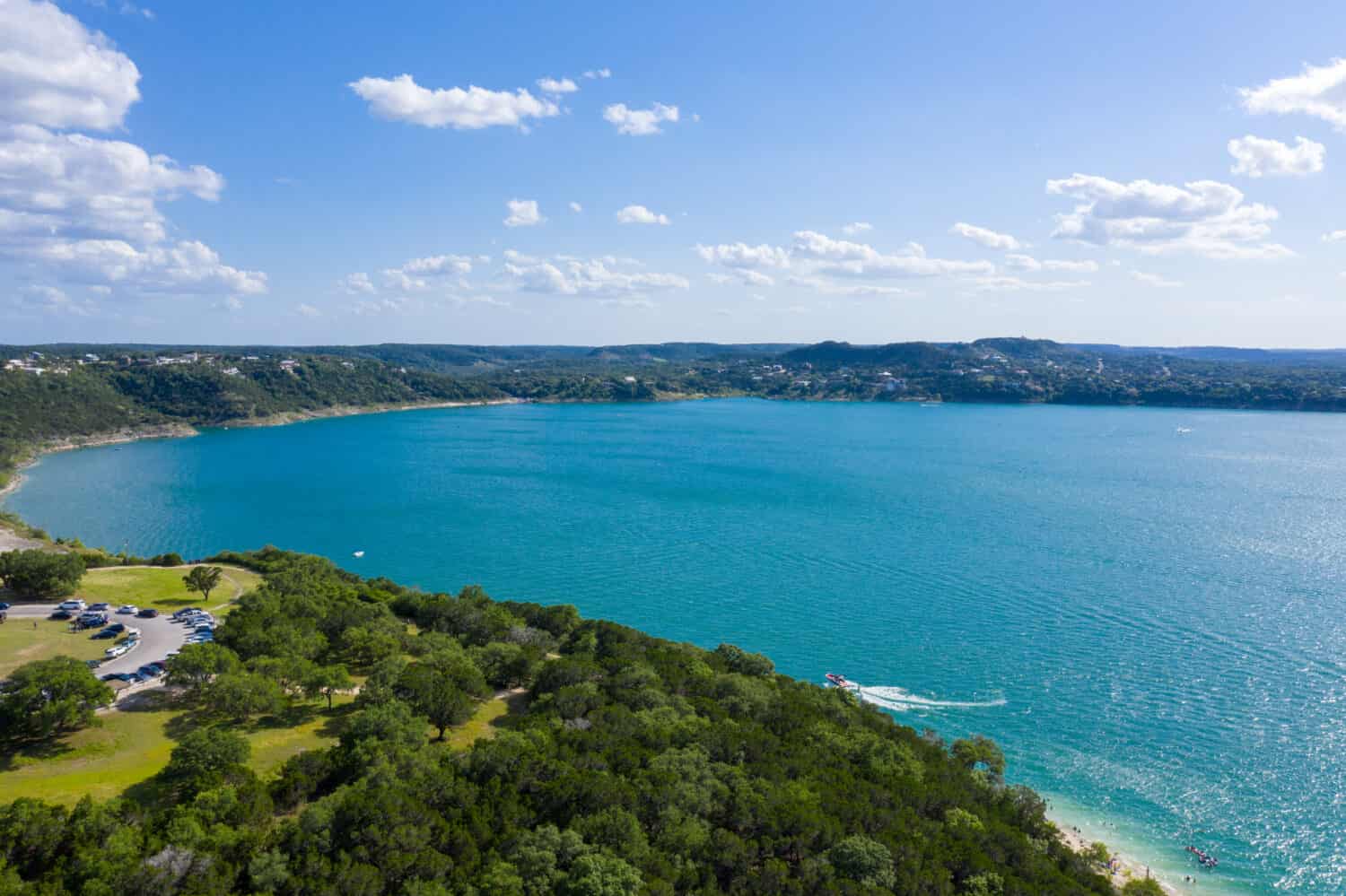
©Dana Rasmussen/Shutterstock.com
Visit the Heritage Museum of the Texas Hill Country
Have an avid interest in local heritage and ancient artifacts? Look no further than the Heritage Museum of the Texas Hill Country! Explore fascinating displays showcasing Native American traditions, the hardships faced by early settlers, and insights into regional military history. A particularly captivating feature is the array of over 200 dinosaur prints left behind approximately 110 million years ago during prehistoric times. Discover them through self-guided tours or expert escorted excursions. History comes alive right before your eyes!
Drive Along the River Road
Consider taking a trip along the stunning River Road route, which runs alongside the tranquil waters of the Guadalupe River from Canyon Lake to New Braunfels. Along the way, discover breathtaking vistas featuring rolling hills, verdant treescapes, and diverse bird species inhabiting the area. Plan stops at several interesting attractions nearby to add excitement to your journey. Here are several interesting stops worth considering:
- Whitewater Sports
- Gruene Historic District
- Schlitterbahn Waterpark
Canyon Lake Fishing: Beyond Size and Depth
Canyon Lake’s massive size stretches across many miles and offers countless opportunities for outdoor adventures. Its deep waters hold secrets beneath their surface — schools of vibrant fish populating every lake corner. These fish come in all shapes and sizes, ranging from Guadalupe bass to majestic catfish. All these fish thrive in the perfect environment created by the lake’s clean water and warm temperature. There are even more exciting things to do here, such as camping, swimming, hiking, and more. The possibilities seem endless!
Up Next:
"fish" - Google News
July 07, 2023 at 02:08AM
https://ift.tt/nqcPZb1
Canyon Lake Fishing, Size, Depth, And More - AZ Animals
"fish" - Google News
https://ift.tt/aro12AI
https://ift.tt/2FBnOSl
Bagikan Berita Ini














0 Response to "Canyon Lake Fishing Size Depth And More - AZ Animals"
Post a Comment